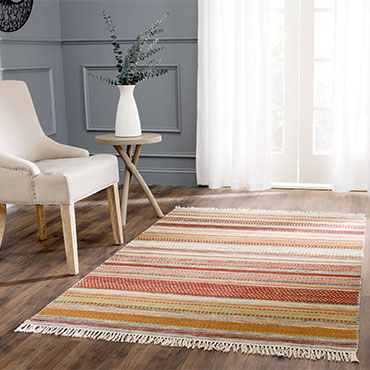The Kilim Collection is an artful display of bohemian styled flat weave rugs. Each Kilim rug is hand woven using pure soft cotton in the finest traditions of nomadic peoples from the Middle East to Central Asia. Styled with tribal-inspired designs renewed for today's fashionable decor, the sublime patterns and striking colors of Kilim create an eye-catching element ideal for classy-casual or rustic room furnishings. Learn More
Kilims
Kilims Guide
 Kilims are traditional flat-woven rugs without a pile, originating from regions such as Turkey, North Africa, Iran, and the Balkans. Known for their geometric patterns and vibrant, bold colors, Kilims are woven using a technique that creates clear, sharp designs, making them distinct and instantly recognizable. These rugs are typically made from wool, which contributes to their durability and warmth. Kilims are not only used as floor coverings but also as tapestries, pillow covers, and other decorative pieces due to their decorative flexibility and cultural significance. Lightweight and versatile, Kilims are prized in contemporary and traditional interiors alike for their ability to add a touch of artisanal craftsmanship and global flair to any setting.
Kilims are traditional flat-woven rugs without a pile, originating from regions such as Turkey, North Africa, Iran, and the Balkans. Known for their geometric patterns and vibrant, bold colors, Kilims are woven using a technique that creates clear, sharp designs, making them distinct and instantly recognizable. These rugs are typically made from wool, which contributes to their durability and warmth. Kilims are not only used as floor coverings but also as tapestries, pillow covers, and other decorative pieces due to their decorative flexibility and cultural significance. Lightweight and versatile, Kilims are prized in contemporary and traditional interiors alike for their ability to add a touch of artisanal craftsmanship and global flair to any setting.Disclaimer: The information provided in this article is for general informational purposes only. While we strive to ensure the accuracy and reliability of the information presented, we make no warranties, express or implied, about the completeness, accuracy, reliability, suitability, or availability with respect to the content. Any reliance you place on such information is strictly at your own risk. We recommend consulting with professionals for specific advice tailored to your project’s needs, particularly regarding building codes, regulations, and product specifications.
Under no circumstances shall we be liable for any loss or damage, including without limitation, indirect or consequential loss or damage, arising from the use of, or reliance on, the information provided in this article.
Featured Brands
The Best 2 Kilims Brands

Safavieh Kilims
Profile | WebsiteThe Kilim Collection is an artful display of bohemian styled flat weave rugs. Each Kilim rug is hand woven using pure soft cotton in the finest traditions of nomadic peoples from the Middle East to Central Asia. Styled with tribal-inspired designs renewed for today's fashionable decor, the sublime patterns and striking colors of Kilim create an eye-catching element ideal for classy-casual or rustic room furnishings. Learn More

Peel Rugs
Profile | WebsiteWhen choosing a Peel 100% wool rug, you'll find that depth of design and quality are foremost in every rug we produce-because a Peel quality assurance director has worked beside the master dyers and weavers who made it; ensuring wool quality; monitoring dye colors; guaranteeing meticulous design integrity; overseeing the finest detail. Learn More
Kilims News
Latest Kilims News
Nine reasons we love flat weave rugs (and you should, too!)...ce the pattern is the same on both sides of the rug. There are any number of variations on the basic technique, with different regions around the world adopting different patterns and styles. Kilims, Dhurrie rugs, and Navajo rugs are just a few of the styles that may differ in some ways, but still display the same general weaving skill. What are the advantages of flat weave... |
Kilims...need to isolate themselves from the humidity present in the earthen floors of their tents. They then applied the very same techniques of flatweave to the making of of floor coverings and called them "Kilims". Since this was the area of paganism, most flatweave designs reflected stylized depictions of the worshipped symbols. Kilim rugs is a tapestry rug woven from fairly harsh, thick wool. ... |
Caucasian Rugs...them easy to work with. Caucasian rugs are only available as scatter rugs: it is rare to find an example over 6x9ft. The opening of eastern Europe has made available some exciting Caucasian kilims. |

